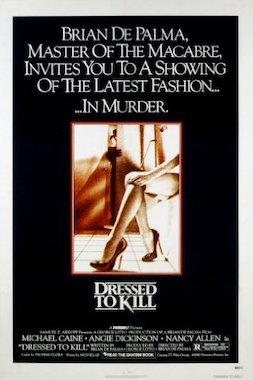
Dressed to Kill is a 1980 American erotic psychological thriller film written and directed by Brian De Palma, and starring Michael Caine, Angie Dickinson and Nancy Allen. It depicts the events leading up to the brutal murder of a New York City housewife (Dickinson) before following a prostitute (Allen) who witnesses the crime, and her attempts to solve it with the help of the victim's son. It contains several direct references to Alfred Hitchcock's 1960 film Psycho.

Dracula is a 1958 British gothic horror film directed by Terence Fisher and written by Jimmy Sangster based on Bram Stoker's 1897 novel of the same name. The first in the series of Hammer Horror films starring Christopher Lee as Count Dracula, the film also features Peter Cushing as Doctor Van Helsing, along with Michael Gough, Melissa Stribling, Carol Marsh, and John Van Eyssen. In the United States, the film was retitled Horror of Dracula to avoid confusion with the U.S. original by Universal Pictures, 1931's Dracula.
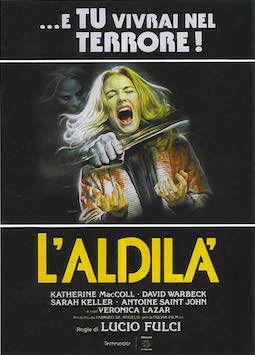
The Beyond is a 1981 Italian Southern Gothic supernatural horror film directed by Lucio Fulci. It is based on an original story created by Dardano Sacchetti, starring Catriona MacColl and David Warbeck. Its plot follows a woman who inherits a hotel in rural Louisiana that was once the site of a horrific murder, and which may be a gateway to hell. It is the second film in Fulci's Gates of Hell trilogy after City of the Living Dead (1980), and was followed by The House by the Cemetery (1981).
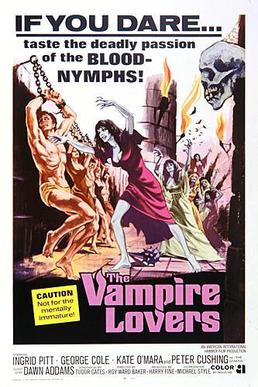
The Vampire Lovers is a 1970 British Gothic horror film directed by Roy Ward Baker and starring Ingrid Pitt, Peter Cushing, George Cole, Kate O'Mara, Madeline Smith, Dawn Addams, Douglas Wilmer and Jon Finch. It was produced by Hammer Film Productions. It is based on the 1872 Sheridan Le Fanu novella Carmilla and is the first film in the Karnstein Trilogy, the other two films being Lust for a Vampire (1971) and Twins of Evil (1971). The three films were somewhat daring for the time in explicitly depicting lesbian themes.

Eyes Without a Face is a 1960 French-language horror film directed by Georges Franju. The film stars Pierre Brasseur and Alida Valli. Based on the novel of the same name by Jean Redon, it revolves around a plastic surgeon who is determined to perform a face transplant on his daughter, who was disfigured in a car accident. During the film's production, consideration was given to the standards of European censors by minimizing gore. Although Eyes Without a Face was cleared by censors, its release in Europe caused controversy. Critical reaction ranged from praise to disgust.

Cannibal Ferox, also known as Make Them Die Slowly in the US and as Woman from Deep River in Australia, is a 1981 Italian cannibal exploitation horror film written and directed by Umberto Lenzi. Upon its release, the film's US distributor claimed it was "the most violent film ever made". Cannibal Ferox was also claimed to be "banned in 31 countries", although this claim is dubious. The title derives from the Latin ferox, meaning cruel, wild or ferocious.
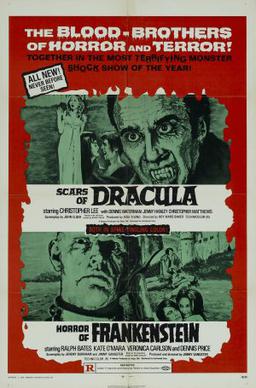
The Horror of Frankenstein is a 1970 British horror film by Hammer Film Productions that is both a semi-parody and semi-remake of the 1957 film The Curse of Frankenstein, of Hammer's Frankenstein series. It was produced and directed by Jimmy Sangster, starring Ralph Bates, Kate O'Mara, Veronica Carlson and David Prowse as the monster. It was the only film in the Frankenstein series which did not star Peter Cushing. The original music score was composed by Malcolm Williamson.

Captain Clegg is a 1962 British adventure horror film directed by Peter Graham Scott and starring Peter Cushing, Yvonne Romain, Patrick Allen, and Oliver Reed. It produced by John Temple-Smith for Hammer Film Productions. It is loosely based on the Doctor Syn character created by Russell Thorndike.
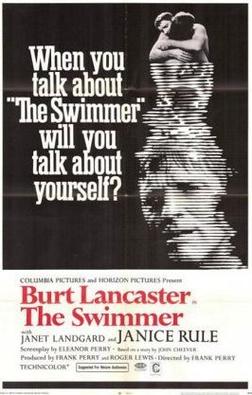
The Swimmer is a 1968 American surrealist-drama film starring Burt Lancaster. The film was written and directed by Academy Award-nominated husband-and-wife team of Eleanor Perry and Frank Perry (director). The story is based on the 1964 short story "The Swimmer" by John Cheever, which appeared in the July 18, 1964, issue of The New Yorker. The 95-minute movie adds new characters and scenes consistent with those in the original 12-page short story.

Vampyres is a 1974 British horror film directed by José Ramón Larraz and starring Anulka Dziubinska, Marianne Morris, and Murray Brown. Its plot follows two female lovers who, having been resurrected as vampires, lure unsuspecting travelers to their dilapidated estate to feed on their blood.
Bob Murawski is an American film editor. He was awarded the 2010 Academy Award for Best Film Editing for his work on The Hurt Locker, which he shared with his wife, fellow editor Chris Innis. He often works with film director Sam Raimi, having edited the Spider-Man trilogy, Oz the Great and Powerful, and Doctor Strange in the Multiverse of Madness. Murawski is an elected member of the American Cinema Editors, and is the co-founder of Grindhouse Releasing, an acclaimed film distribution company specializing in re-releases of cult films.

Grindhouse Releasing is a Hollywood-based independent cult film distribution company led by film editor Bob Murawski and co-founded by Sage Stallone. Grindhouse digitally remasters, restores, and produces bonus materials and video documentaries for cult film DVDs and Blu-rays which it distributes on the CAV label.

The Poughkeepsie Tapes is a 2007 American pseudo-documentary horror film written, directed, edited, and co-developed by John Erick Dowdle. It is about the murders of a serial killer in Poughkeepsie, New York, told through interviews and footage from a cache of the killer's snuff films.

Pigs is a 1973 American psychological horror film co-written, co-produced, and directed by Marc Lawrence and currently distributed by Troma Entertainment. The film stars Toni Lawrence.

Don't Answer the Phone! is a 1980 American psychological horror film co-written and directed by Robert Hammer.
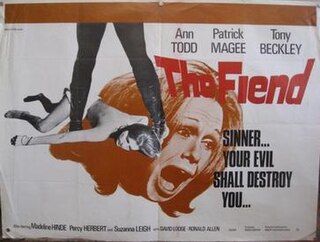
The Fiend is a 1972 British horror film produced and directed by Robert Hartford-Davis and starring Ann Todd, Tony Beckley and Patrick Magee. The film is set against a background of religious fanaticism and, as with other films directed by Hartford-Davis, includes elements of the sexploitation genre of the early 1970s.

House of Mortal Sin is a 1976 British horror slasher film directed and produced by Pete Walker. It was scripted by David McGillivray from a story by Walker. Its plot concerns a deranged priest who takes it upon himself to punish his parishioners for their moral transgressions.
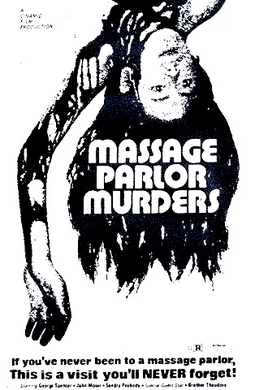
Massage Parlor Murders! is a 1973 American exploitation-crime-horror film directed by Chester Fox and Alex Stevens. The film stars George Spencer, John Moser, Sandra Peabody, Brother Theodore and George Dzundza, who respectively portray Rizotti, Detective O'Mara, Gwen, Theodore, and Mr. Creepy. The film revolves around the detectives Rizotti (Spencer) and O'Mara (Moser) as they investigate the murders of massage parlor workers in the New York area. Marketed as being similar in tone to Alfred Hitchcock's psychological horror film Psycho (1960), the film was released into drive-in theaters and the grindhouse circuit in 1973. Subsequently, the film began to be advertised as a sexploitation film and was released under the title Massage Parlor Hookers! with the horror film elements being removed. The film did not have a home video release until 2013.
Randee Lynn Jensen, born April 28, 1949 is an actress from San Bernardino, California. During the 1960s she acted in films such as The Pit and the Pendulum and The Gay Deceivers. From the late 1960s to the early 1970s, she had a number of parts in exploitation and biker films. She had appeared in over ten films in the biker genre alone. These include The Glory Stompers, The Cycle Savages and The Girls from Thunder Strip. She has also worked in film production, casting and other behind the scenes roles. Prior to her main work in film she had done stage work.

Witchtrap is a 1989 American supernatural horror film written and directed by Kevin S. Tenney and starring James W. Quinn, Kathleen Bailey, and Linnea Quigley. The film follows a team of parapsychologists who attempt to exorcise a haunted inn with the help of a device designed to lure in and trap evil spirits. Despite the film's title, its central villain is a male witch also known as a warlock. Witchtrap was released direct-to-video.


















